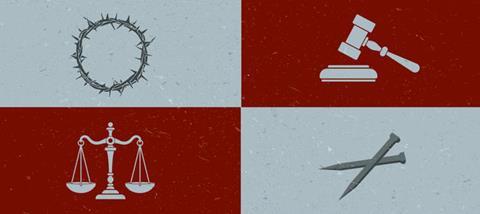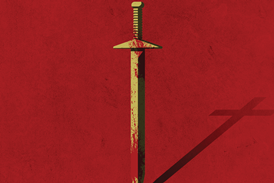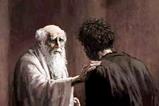The doctrine of penal substitutionary atonement has divided Christians in recent years. David Instone-Brewer takes a fresh look at what the Bible says

One of my biggest professional gaffes was when I was sent Steve Chalke’s The Lost Message of Jesus (Zondervan) before publication, and I didn’t spot how people might misconstrue his message. In particular, a nasty quote from the Japanese American theologian Rita Nakashima Brock, who compared the crucifixion to ‘cosmic child abuse’.
Steve said that he disagreed with this, arguing that the crucifixion was not like that, but for many readers he didn’t disagree enough. For the record, I’d like to say that the crucifixion isn’t in any way, remotely, ever to be regarded as that! Sometimes, though, when I preach about the crucifixion, a listener might think that’s what I’m saying it is – and I suspect this is why I react so strongly against this ghastly phrase.
AVOIDING THE PROBLEM
I have often preached things like: ‘My sins were wiped away when God poured the agonies of my punishment onto Jesus.’ This means that God himself was punishing Jesus with one of the cruellest forms of torture ever invented. But when I think about it, I realise that I am in danger of portraying God as though he was uglier than some of the amoral Greek and Roman gods. Perhaps unwittingly, I’m presenting the holy God as a perpetrator of parental cruelty, which is regarded as revolting and illegal in every civilised society. I’ve been surprised to find that the Bible itself avoids this problem.
We have to be very careful how we present penal substitution (the idea that Jesus carried the penalty for our sins). John Stott warned in The Cross of Christ (IVP) against using a ‘crude construction’ based on penal substitution such as: ‘A sacrifice to appease an angry God, or...a legal transaction in which an innocent victim was made to pay the penalty for the crimes of others’. This view of the cross does help to explain why Jesus had to suffer so terribly, and it helps us understand how a just God deals with sin but, like all images or metaphors, not every detail fits the full meaning of the crucifixion perfectly. As soon as we explore the idea that God himself carried out the punishment of Jesus, we fall into problems.
The main Bible passage concerning penal substitution is Isaiah 53, where a servant of God is portrayed as suffering on behalf of sinners. This is applied to Jesus in various places (especially John 12:38; Acts 8:32-33; Romans 4:25; 1 Peter 2:21-25). These passages emphasise the rejection and suffering of Jesus, but none of them say that God himself was the source of his suffering. The closest we get to this is that God ‘laid on him’ our sins (without mentioning punishment) and that this suffering was ‘the will of the Lord’ (Isaiah 53:6,10). But the author of the actual punishment isn’t named, except perhaps as ‘mankind’ in verse 3.
The Bible tells us that Jesus suffered the consequence of sin and ‘the curse of the law’ (Galatians 3:13), and that his suffering saves us from God’s wrath (Romans 5:9; 1 Thessalonians 1:10; 5:9). But we never read that God himself turned his wrath, punishment or curse on Jesus. Of course, we can choose to infer what is not stated in the text – by the fact that Christ died to take our sins, and we no longer face punishment – but we have to realise what we are doing: we are filling in a detail that the Bible is silent about. Jesus did not suffer in hell for his sins, like other humans, so what he suffered was not our actual punishment but another punishment that was presumably equivalent. Many theorise that the separation from God that he expressed on the cross was the most severe part of this. But the only actual source of this punishment that the Gospels tell us about was sinful humans.
We never Read that God himself Turned his Wrath on Jesus
INCOMPLETE IMAGES
This punishment imagery isn’t the only way that the Bible attempts to explain the crucifixion. We are also told that Jesus redeemed us (ransomed us back from slavery or kidnapping, see Mark 10:45); he reconciled us (repaired our broken relationships with God, see Romans 5:10); he nulified the law (Ephesians 2:14-15); and he defeated demonic forces at the cross (Colossians 2:14-15). These are all good pictures and explanations of what happened at the crucifixion, but each is inadequate by itself.
We know that these are incomplete images rather than the full explanation because, like parables, they become inconsistent when we try to investigate details that aren’t explored in scripture. For example, if the enemy was defeated, then why pay any ransom money? If the law was cancelled, then why was any punishment required? But these questions are like asking: is an electron a particle or a wave? The answer is that electrons are both, but neither in all aspects. Both the cross and atomic physics are more complex than the images used to explain them. Each of these scriptural images of the cross gives us only partial insights into a reality that our minds can’t fully comprehend.
Isaiah 53 is a precious insight into the crucifixion. It tells us that Jesus’ suffering was real human agony. It helps us understand the dereliction and sense of abandonment behind his cry, ‘My God, my God, why have you forsaken me?’ (Matthew 27:46). It is theologically important because it shows that his death can ‘justify’ the sinner (Isaiah 53:11) – removing our sin so completely that we are declared innocent – which Paul takes up in Romans 5. However, when we infer from this that he was being punished by God, we should be aware that we are concluding something that scripture itself avoids stating.
So how do we understand the cross? I believe JI Packer gave us the solution: ‘The mystery of God is more than any one model, even the best, can express.’ The Bible gives us many ways to comprehend the crucifixion, and we need them all to fathom even a little about God’s love and mercy enacted that day on Mount Calvary.




































